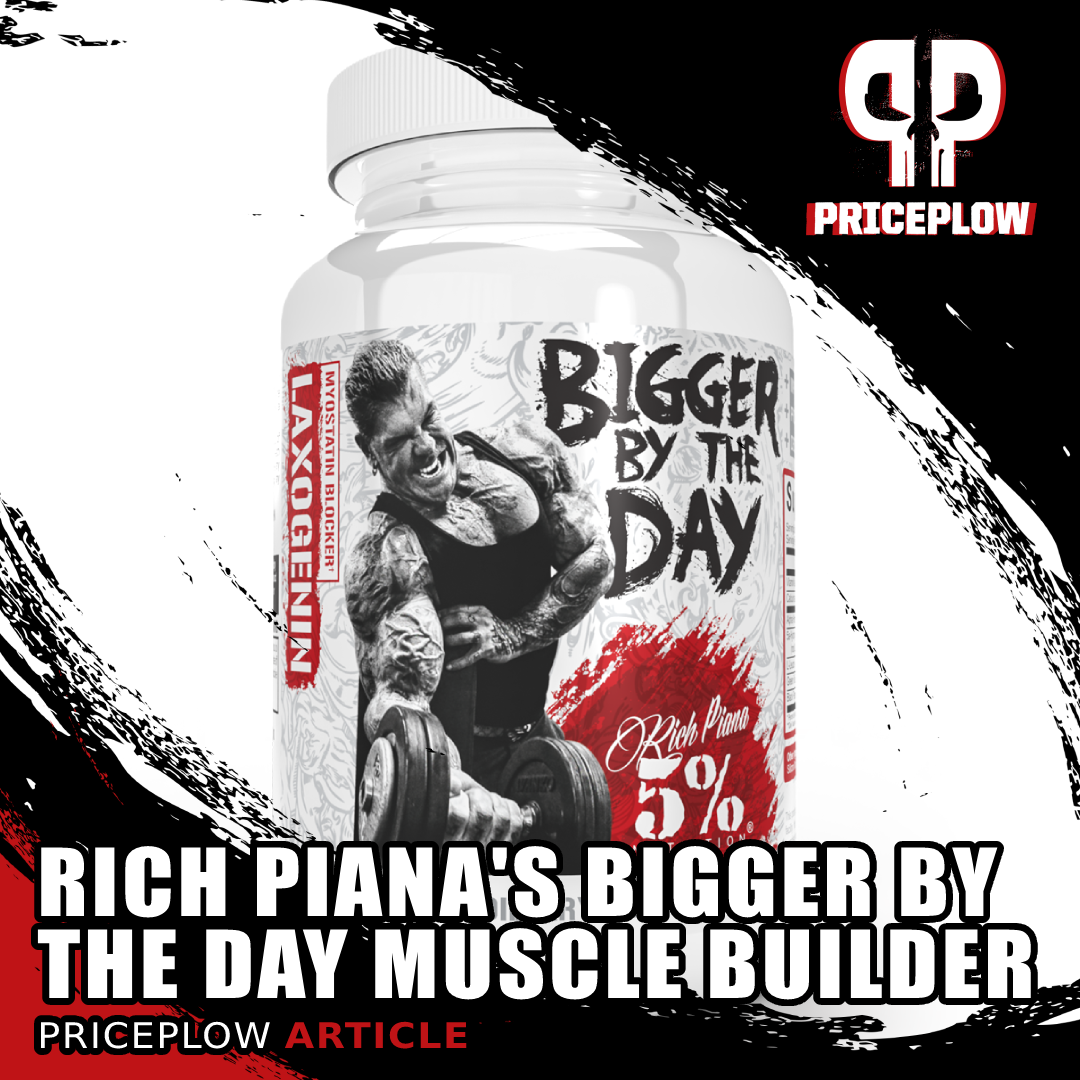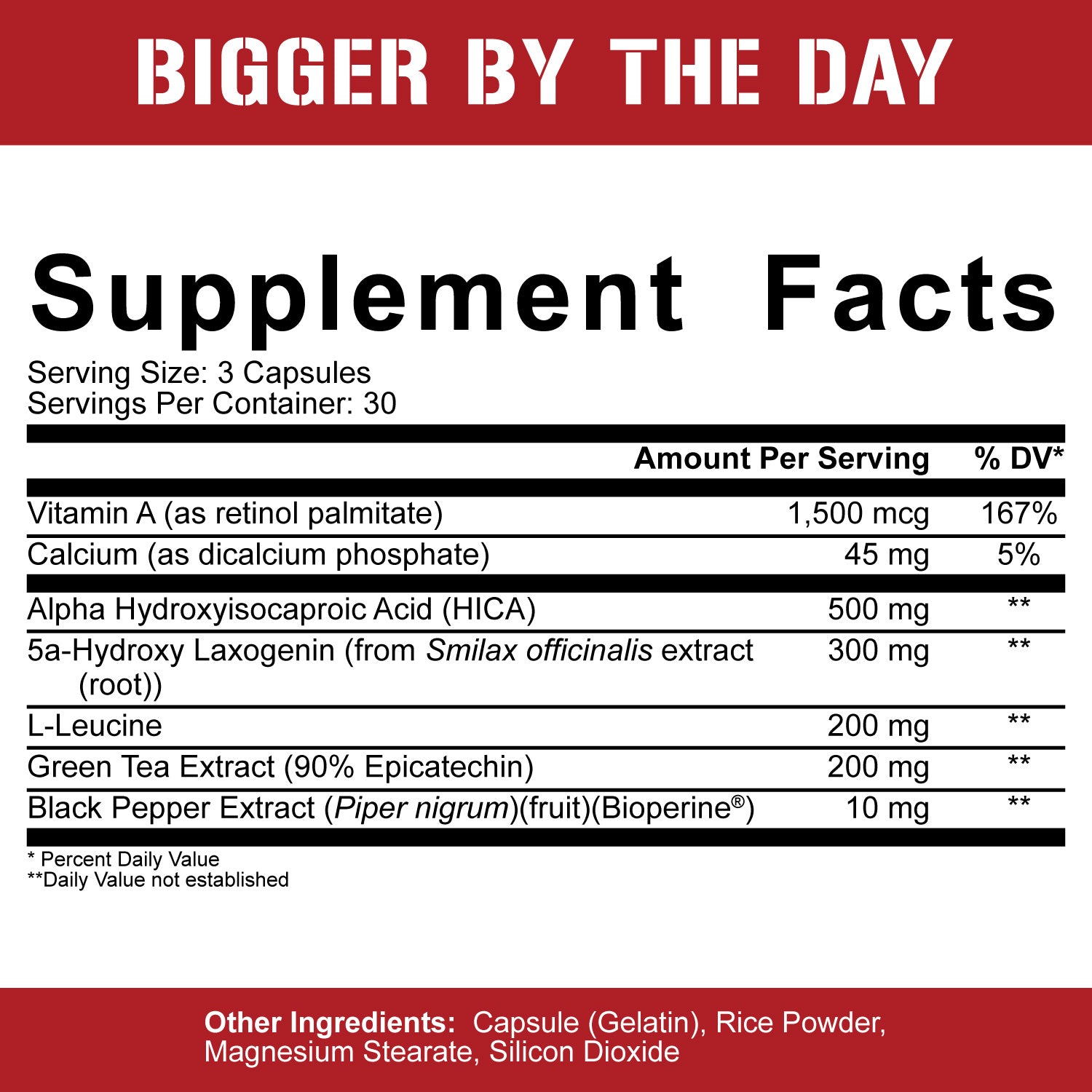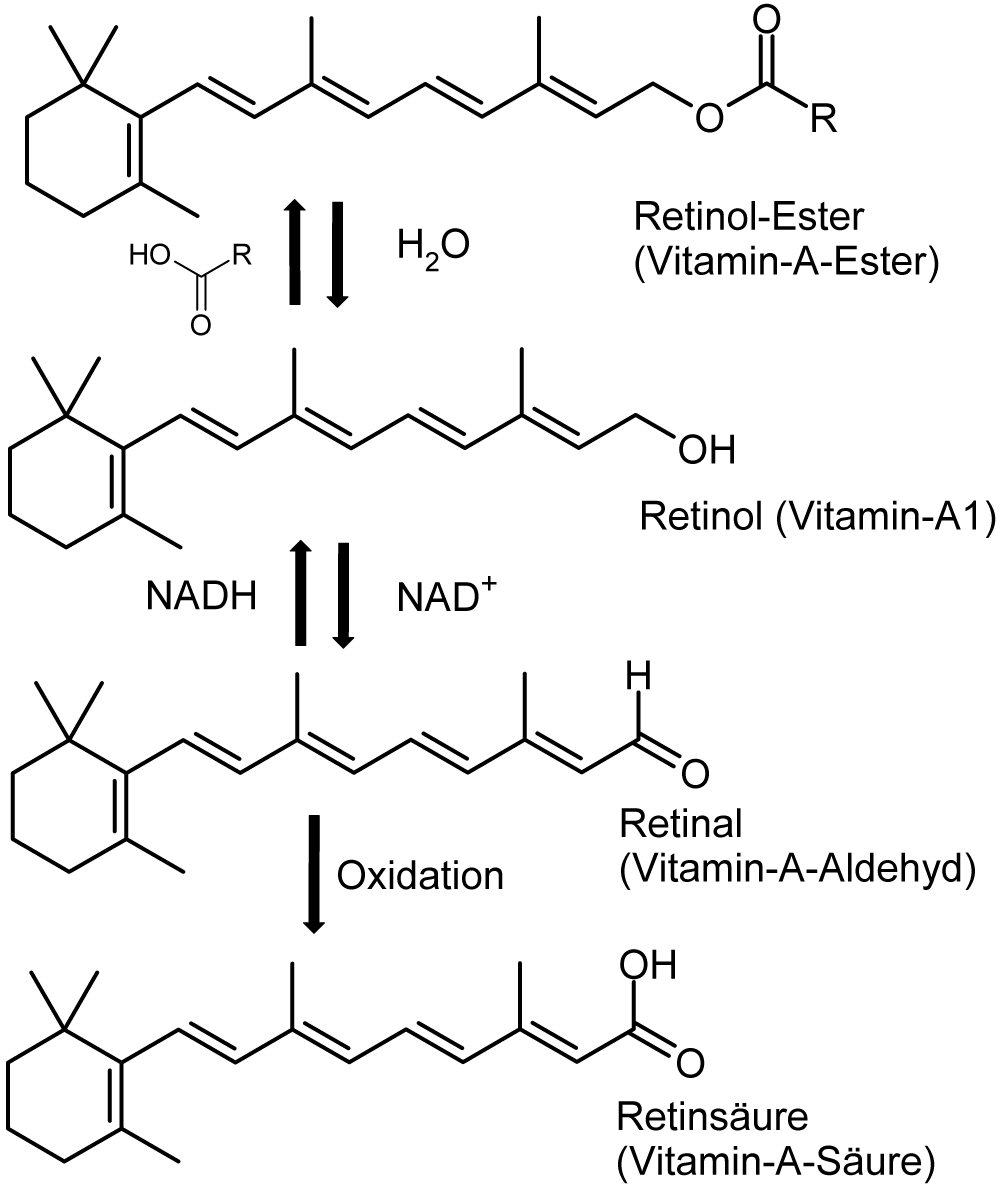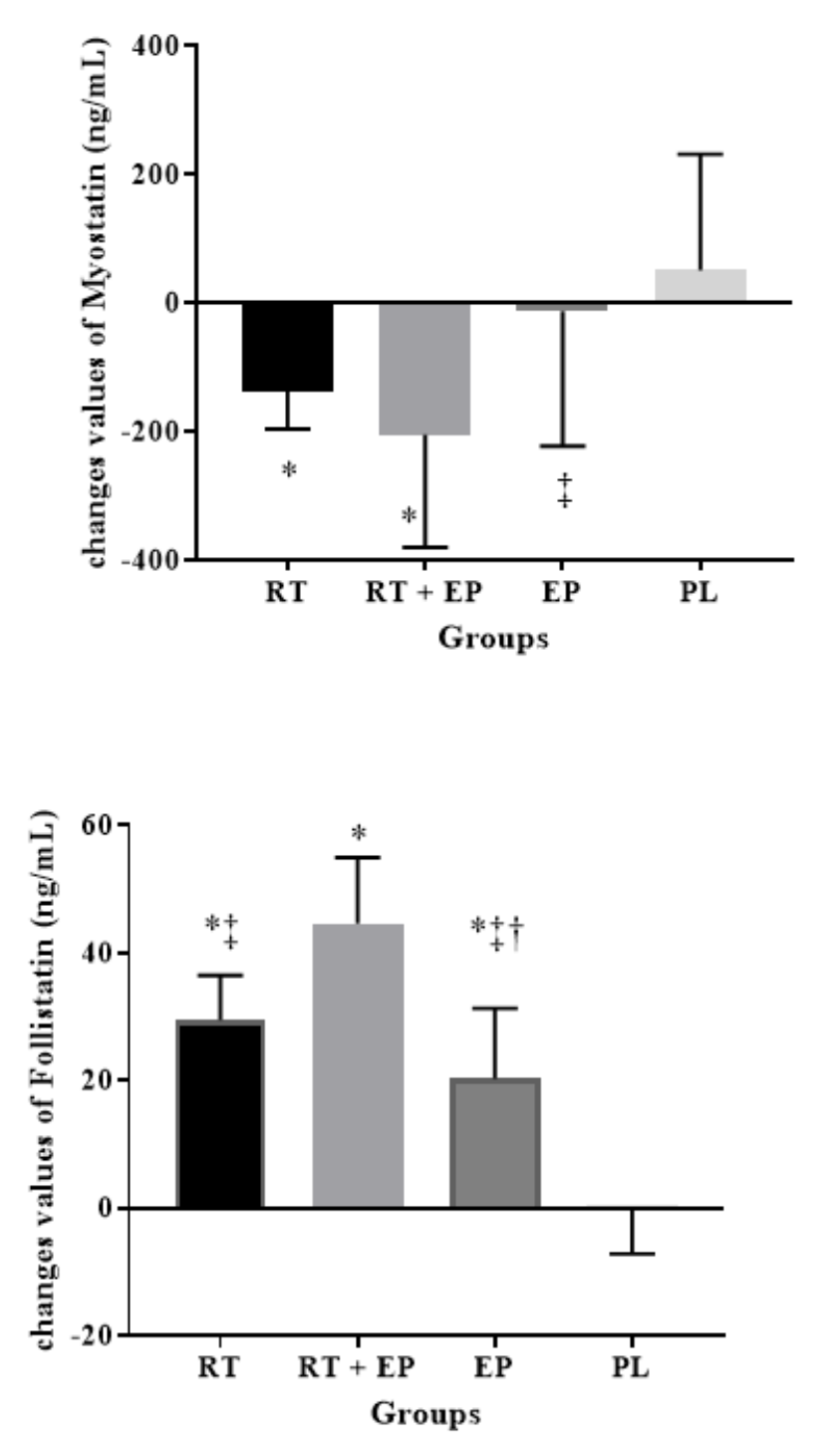Legendary Rich Piana knew at least one thing for sure: only 5% of the people on this planet have the drive and passion to truly pursue and accomplish their dreams. He founded his supplement company, 5% Nutrition, with the aim of supporting those exceptional people's attempts to achieve whatever they set out to do in life.
Although 5% Nutrition designs and manufactures a wide variety of products that help enable a wide variety of aspirations, there was probably nothing nearer or dearer to Rich Piana's heart than getting f***ing huge.
Today we'll be discussing a supplement that's designed to help any serious athlete or lifter pack on the lean muscle gains.
BIGGER BY THE DAY? That sounds familiar...
It's called Bigger By The Day, a name that may sound familiar because it was the name of an insanely incredible series of videos in late 2015 and early 2016 from Rich Piana:
In his series, he documented everything about his growth - with some videos (such as Day 14 embedded below) where he logged over 5 million views:
Bigger by the Day Muscle Builder
Back to the new supplement, which consists of a handful of carefully-selected and cutting-edge ingredients, Bigger By The Day has some direct anabolic effects, some anti-catabolic activity, and some support for general metabolic and hormonal health. Obviously, it alone won't get you to Rich Piana size, but it may help you get over a few humps.
Let's take a closer look at how it works after checking in on the prices and availability with PricePlow:
Rich Piana 5% Nutrition Bigger By The Day – Deals and Price Drop Alerts
Get Price Alerts
No spam, no scams.
Disclosure: PricePlow relies on pricing from stores with which we have a business relationship. We work hard to keep pricing current, but you may find a better offer.
Posts are sponsored in part by the retailers and/or brands listed on this page.
Bigger by the Day Ingredients
In a single three (3) capsule serving of Bigger By The Day from 5% Nutrition, you get the following:
-
Vitamin A (as retinol palmitate) – 1,500 mcg (167% DV)
The first thing to note about the inclusion of vitamin A is that 5% Nutrition has opted for a retinol form, as opposed to the carotenoids that are often found in plant foods and considered "vitamin A" by nutritional scientists.
This matters because carotenoids are not actually the form of vitamin A that's used by the human body – they must be converted into retinol, which is the active form.[1]
Because the efficiency of this conversion process is different depending on individual genetics[2] and other factors, supplementing with carotenoids is not a reliable way to boost one's vitamin A levels.
In order to avoid vitamin A deficiency, it's much better to eat animal foods like butter, egg yolk, and liver, which all contain naturally occurring retinol[1] that can be directly metabolized by the body without being bottlenecked by a rate-limited conversion.[2]
Unfortunately, many Americans do not eat enough retinol-containing foods to stave off vitamin A deficiency (VAD). The "2005-2016 National Health and Nutrition Examination (NHANES)" survey found that almost 50% of the American public gets inadequate levels of vitamin A from diet.[3]
That's a big problem because it's pretty much impossible to achieve optimal health without adequate vitamin A.
Animal products -- like the ones Rich Piana would eat -- bring the active form of Vitamin A. Image courtesy Wikimedia
One of vitamin A's chief functions is supporting the thyroid. In fact, vitamin A appears to regulate the function of the whole thyroid-pituitary axis (HPA).[4] When a person is deficient in vitamin A, his or her thyroid will absorb iodine less efficiently.[4] It's a big issue in itself because low levels of iodine can cause hypothyroidism, which ultimately leads to a lowered basal metabolic rate (BMR).
Furthermore, the combination of vitamin A and iodine deficiency can produce more severe symptoms of hypothyroidism than just iodine deficiency.[4]
Anyone seeking to optimize their body composition should take note because the thyroid is the "master switch" of the entire human metabolism and sets a person's BMR, which is defined as the number of calories a person would burn daily if they remained at rest all day.[5] That's why thyroid dysfunction is associated with gradual weight gain, eventually resulting in full-blown obesity[5] if not treated.
Hormones produced by the thyroid gland also regulate your body's levels of leptin,[6] a hormone that signals satiety, prompting you to stop eating when your metabolic needs have been met. Leptin dysregulation is associated with obesity, so we want to make sure that our leptin levels are optimal at all times.[7]
So anyone who wants to naturally burn fat while eating less should strongly consider supporting his or her thyroid with solid vitamin A supplementation.
A research summary of vitamin A
Here's a summary of just some of vitamin A's benefits for human health:
- Obesity and diabetes: animal studies of the nutrient have shown that when vitamin A receptors (also known as retinoic acid receptors or RARs) are stimulated they have anti-diabetic and anti-obesity effects, largely because RAR activity increases insulin sensitivity,[8] which is considered by many to be the "holy grail" of overall metabolic health. In mice whose RARs had been genetically "knocked out," glucose metabolism was disturbed.[9]
- Improved sleep: RAR activity has also been associated with a higher quality of REM sleep and the prevention of age-related declines in sleep quality in mice.[10]
- Better fertility: RAR stimulation plays a central role in the production of new sperm,[11] and RAR knockout mice show impaired testicular function.[12]
- Immunity boost: stimulating RARs leads to the production of new immune cells[13] and a vitamin A deficiency seems to impair immune response.[14]
- Gut health: in studies of cell cultures, vitamin A has been found to help maintain the integrity of the stomach's epithelial barrier,[15] which is responsible for keeping undigested food from leaking out of the gut. If the epithelial barrier is compromised it can lead to "leaky gut," which can result in inflammatory disorders or even autoimmune disease.[16]
- Skin and eye health: vitamin A is famous, as most of us have heard, for promoting the health of skin and eyes.[17,18]
Vitamin A toxicity?
Unfortunately, you can get too much of a good thing, and this is especially true in the case of vitamin A.
Vitamin A is fat soluble, meaning that it can build up in our stored body fat if taken in excess. If the overdose is chronic, then our vitamin A stores can reach toxic levels.[19]
When beginning any retinol supplementation, we strongly recommend calculating your total retinol intake from all sources (not just supplements), and ensuring that it stays under the tolerable upper limit (TUL) of 3,000 micrograms per day.[20]
-
Alpha Hydroxyisocaproic Acid (HICA) – 500 mg
Also known as leucic acid, HICA is a leucine metabolite that has shown promise as an anabolic agent.
Leucine itself (also covered below) is known as the amino acid that's primarily responsible for activating the body's mammalian target of rapamycin (mTOR) pathway, which drives the synthesis of new skeletal muscle. HICA is actually more effective than leucine at doing this, partly because it's absorbed faster and used more quickly.
In the research literature, HICA has been observed to reduce soreness,[21] increase muscle mass,[21] and decrease fat mass.[21]
This graph from the ground-breaking HICA study shows the clear differences adding HICA can have on your overall lean mass after only 4 weeks of use![21]
The reduction in delayed onset muscle soreness (DOMS) in particular is pretty huge for people who train hard, like athletes and bodybuilders. Just note that the studied doses are typically two to three times larger than the 500 milligrams we're given here. So if you want to maximize the effects of HICA supplementation, consider stacking Bigger By The Day with another source of HICA to achieve the 1.5 grams per day that was used in the study we cited.[21]
-
5a-hydroxy laxogenin (from Smilax officinalis) – 300 mg
Laxogenin is a plant compound that occurs naturally in the Smilax genus of plants. It belongs to a chemical class called brassinosteroids – steroid hormones that regulate the growth of plants and were first identified in the Brassica genus, which they're named after.
If you're worried about running afoul of anti-doping regulations or messing up your hormonal system, you can rest assured that brassinosteroids are both non-hormonal and legal. Also, they do not cause any of the side effects associated with anabolic steroid use.
TEN forms of creatine? YES. This is what you stack with Bigger by the Day -- Crea-Ten.
Early research has shown that laxogenin promotes muscle protein synthesis and inhibits muscle protein breakdown,[22,23] making it a powerful one-two punch for anyone who's trying to get strong and lean.
One study on laxogenin found that it also promotes athletic performance compared to a placebo control.[22] Additionally, laxogenin has been shown to improve recovery, lower cortisol, and decrease inflammation.[24]
However, it should be noted that although these results are promising, they come from animal models and should be considered preliminary. But that's pretty much par for the course if you're trying to stay on the cutting edge of supplement science.
In general, we see anecdotally some strength gains from laxogenin as well. Be smart and talk to a physician if you have any concerns about the safety of laxogenin.
-
L-Leucine (200 mg)
Leucine is one of the branched-chain amino acids (BCAAs), which have been studied extensively as a group for their anti-catabolic[25-27] and endurance-promoting[28-30] properties. The latest research suggests that leucine is the main driver behind the effects of BCAAs since it initiates muscle protein synthesis through mTOR activation,[31-33] which is why 5% cuts to the chase here by including just leucine.
A smaller dose than usual at just 200 milligrams, but remember that this leucine is being stacked with HICA, which is a leucine metabolite. So the combination of this leucine and its own metabolite is probably having a biological effect equivalent to a much larger dose of leucine.
-
Green Tea Extract (90% epicatechin) – 200 mg
Epicatechin is a flavanol that occurs naturally in dark chocolate and green tea. In recent years, it's become a popular supplement ingredient because of its documented ability to increase muscle mass gains and athletic performance. The research literature shows the following benefits associated with epicatechin consumption:
This recent study was performed on elderly, but alongside resistance training, epicatechin had the best results on myostatin and follistatin levels![34]
- Increased strength and muscle growth[35,36]
- Increased glucose tolerance[37]
- Higher physical endurance [38]
- Reduced fatigue[38]
- Increased nitric oxide (NO) production[39]
A big part of the reason that epicatechin is able to do all this is that it inhibits myostatin, a protein compound that inhibits muscle growth.[36]
-
Black Pepper Extract (BioPerine) – 10 mg
A common criticism of nutritional supplements is that, owing to the uneven bioavailability of supplement ingredients, the consumer is liable to pass most of them unabsorbed and end up paying for "expensive pee".
That's where BioPerine comes in: by inhibiting the stomach enzymes that break these ingredients down,[40] it massively increases their bioavailability, pretty much across the board. Because of this, you'll see BioPerine used in a wide variety of nutritional supplements, from multivitamins to pre-workouts.[40]
Beyond merely enhancing the effectiveness of other ingredients, BioPerine has some benefits of its own, too. It's been shown to upregulate a transporter called GLUT4,[41] which moves glucose out of the bloodstream and into muscle tissue where it belongs. It also helps improve insulin sensitivity and fatty liver,[42] and has antioxidant activity.[43]
The obvious stack choice here is Rich Piana's classic creatine supplement, Crea-Ten. If you're big on carbs, drive them in with Freak Show and don't forget to sip on ALL DAY YOU MAY!
Get Bigger by the Day
Overall, Bigger By The Day is a good supplement and worth the money, but understand that this alone will obviously not make you Rich Piana (and for most people, nothing will - Rich was nearly untouchable in that department). But for some natty size and strength increases, it may be able to push you past a plateau.
We would like to see a bigger dose of leucine since doses in the 200-milligram range are not typically studied in research settings. But since the main value of leucine is in its signaling activity, even a dose this small is probably of significant value. It's also better than filling the rest of the capsule with rice flour!
One thing to keep in mind about leucine here is that it's being stacked with one of its own metabolites — HICA. So the overall "leucine-driven effect" of the leucine and HICA is almost certainly much larger than 200 milligrams of leucine would suggest.
Rich Piana 5% Nutrition Bigger By The Day – Deals and Price Drop Alerts
Get Price Alerts
No spam, no scams.
Disclosure: PricePlow relies on pricing from stores with which we have a business relationship. We work hard to keep pricing current, but you may find a better offer.
Posts are sponsored in part by the retailers and/or brands listed on this page.










Comments and Discussion (Powered by the PricePlow Forum)